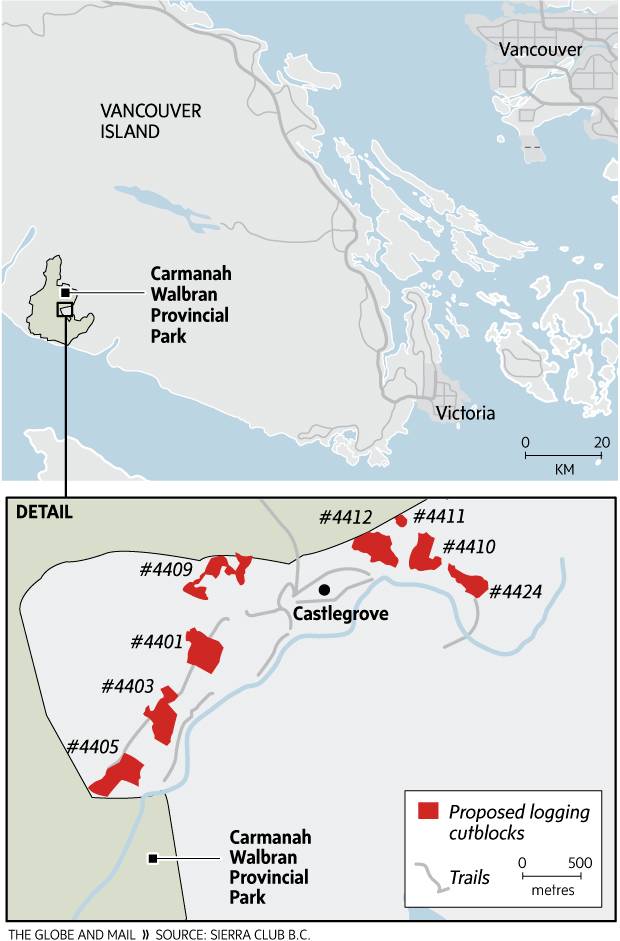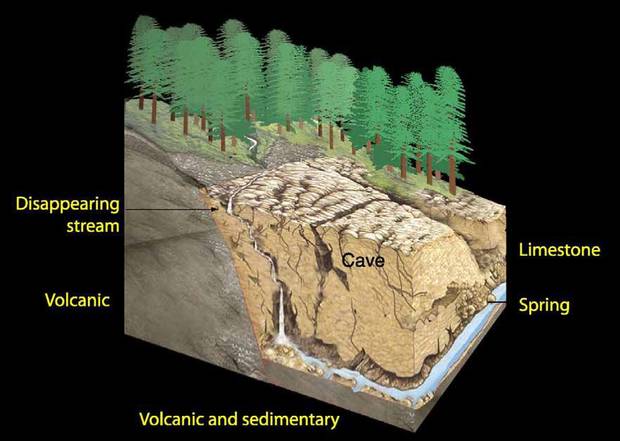Near the foot of an ancient Western red cedar, a sinkhole leads to a hidden world. With a bit of wriggling, it is possible to disappear below the surface to find delicate ferns dangling from pockets in walls of limestone. The water from the underground stream that carved its way through the rock tastes soft and pure.
British Columbia's coastline boasts the most significant karst terrain on the continent – magnificent canyons of marble and limestone caves hewn, over tens of thousands of years, by the relentless force of water. These are places where rare species thrive, and secret rivers feed forests and fish-bearing waterways.
They also help produce big, healthy trees coveted by the forest industry.
Members of Vancouver Island's caving community have spent years documenting incidents where logging has left caves and sinkholes damaged, sometimes stuffed with industrial debris. This summer, cavers and karst specialists combed the Walbran Valley, on the southwestern edge of the island, hoping to identify sensitive spots before forestry crews arrive to harvest the giant cedars that have taken hold on a fragile karst landscape.
Emerging from the sinkhole on a wet November day, activist Mark Worthing of the Sierra Club of B.C. pointed to a tree marked with pink surveyor's tape about 15 metres up the slope. The tape maps out the route of a proposed logging road. If the province approves logging here in cutblock 4403, this unique landscape could be drastically altered, disrupting the thin layer of soil in which new trees can begin.
"You can replant an old-growth forest, but you create an entirely different landscape. When it is an old-growth forest on karst, though, logging is the nail in the coffin," Mr. Worthing said. Studies of logging on karst landscape on the north end of Vancouver Island show limestone slopes are painfully slow to recover – it may take centuries for the soil base to rebuild enough to sustain new growth.
Peter Cressey on the hunt for karst lights up the forestry bounder markers.
John Lehmann/The Globe and Mail
To quell anti-logging demonstrations, much of the Walbran Valley was protected 20 years ago with the creation of a provincial park that includes some of the world's largest and oldest spruce and cedar trees. But part of the valley, dubbed "the bite," was left outside the park boundary, and it is here that logging company Teal Cedar Products Ltd., a division of the Teal Jones Group, now wants to cut the valuable old-growth trees.
Caving enthusiasts have joined a new round of environmental protests. Vancouver Island has more than 1,000 explored limestone caves and an active membership in the caving organization the B.C. Speleological Federation.
On Nov. 24, the logging company won a court injunction to end a blockade aimed at its logging operation in an adjacent cutblock. Teal Jones officials declined interview requests, but said in a statement: "We are aware of the limestone and karst geology resources in the vicinity of Block 4403 and as a result, we are planning to conduct a formal karst field assessment for this area prior to finalizing any road construction and harvesting plans."

Charly Caproff, who is pursuing a degree in Environmental Resource Management at Simon Fraser University, has been studying the karst in the valley. Her tests on the water in cutblock 4403 suggest a huge underground system. "Nobody has really gone in and looked at the hydrological systems. Or seen what the biology is down there. You are logging and destroying something you don't have an understanding of. It's crazy."
Significant karst landscapes are protected by government regulation on Vancouver Island, but a report by the independent Forest Practices Board in 2014 concluded the protection regime has large gaps. The forest industry is responsible for ensuring it does not "damage or render ineffective" important karst features, but those terms are not defined, there are no criteria for karst experts who conduct the assessments, and the province's karst management handbook was disregarded more often than not, the report said.
The board could not prove that logging had damaged karst, but noted it is often impossible to see what is taking place below the surface. "To prove damage or rendered ineffective for many karst features would require long-term baseline data to compare features pre- and post-harvesting," the report says. "However there is little research being done in B.C."
Martin Davis, a karst and bat specialist, last summer explored the karst in the cutblocks proposed by Teal Cedar Products. Although he did not find any that would sustain large numbers of bats over the winter, he did log a healthy bat population – unsurprising because both the karst and old growth trees offer perfect habitat for roosting and hibernation. "There should be a proper karst inventory around these blocks and in the adjacent areas," he said in an interview. "My visit with two other cavers was not thorough, and we could have easily missed features."

Mr. Davis is skeptical about the government's commitment to ensure significant karst features are kept intact. He produced a detailed list for the caving community two years ago of karst sites damaged by logging. "The B.C. Speleological Federation had brought these complaints forward to the provincial government, but no action was taken at that level, despite these practises violating provincial standards," he said.
Steve Thomson, Minister of Forests, Lands and Natural Resource Operations, said forest companies and recreational cavers need to work together to ensure special karst features are not harmed. "We recognize there is a need for engagement and for communication with local caving community."
He also acknowledged the province needs to do a better job of setting out its expectations, and said the protocols and the guidebook for managing karst features are being updated.
The boundaries of Carmanah Walbran Provincial Park were set in 1995 by the New Democratic Party government, when Dan Miller was the minister of forests. Mr. Miller, long retired from politics, recalls the fierce battle over logging in the Walbran – both in public and within his party's caucus. It took painstaking negotiation to reach a compromise between environmental values and resource jobs. "Some was allocated to park, and some was part of the working forest," he said.
With new issues – preserving the water, the bats, the soil and the rocks – emerging that were not contemplated 20 years ago, when the primary concern was the trees, he said today's environmentalists and forest executives need to find a way to meet in that same spirit of compromise. "The rights of Teal Jones come into this picture," he said. "The question is, is there a way to resolve the issue?"
Peter Cressey and Mark Worthing in the Walbran Valley.
John Lehmann/The Globe and Mail
A karst explainer
What is karst?
Karst landscapes are created by water dissolving soluble rock – usually marble, limestone or dolomite. The process can take tens of thousands of years, and Vancouver Island's temperate rainforests boast some of the most significant karst landscapes in North America because the terrain is evolving – in geological time – at a rapid pace.
How is karst protected?
Under the Forest and Range Practices Act, the province has set out a Government Action Regulation order for karst caves, significant surface karst features and important features and elements on Vancouver Island with karst terrain of high and very high vulnerability. Forest companies are responsible for identifying these and ensuring their activities "do not damage or render ineffective" karst features.
What is the risk?
The province's 12-year-old Karst Management Handbook notes that karst ecosystems often support unusual or rare plant and animal species, and water quality can be affected by logging activities. "The potential for karst hydrological systems to transport air, water, nutrients, soil and pollutants into and through underground environments should be carefully considered when developing and implementing management strategies for karst landscapes."
Who decides what is significant?
The handbook says reserves should be established around "significant cave entrances; above significant caves; significant surface karst features; significant karst springs; and unique or unusual karst flora/fauna habitats." It does not define "significant," but calls for "experienced professionals" to determine that. The Forest Practices Board has found there are no criteria to determine whether an individual is qualified to complete a karst assessment.
…